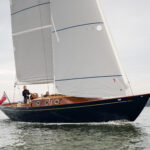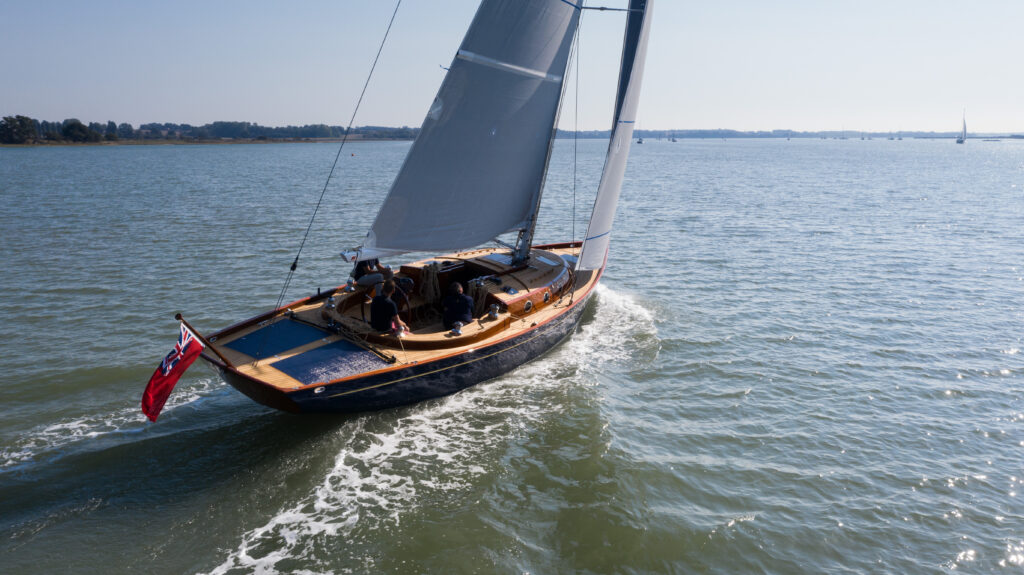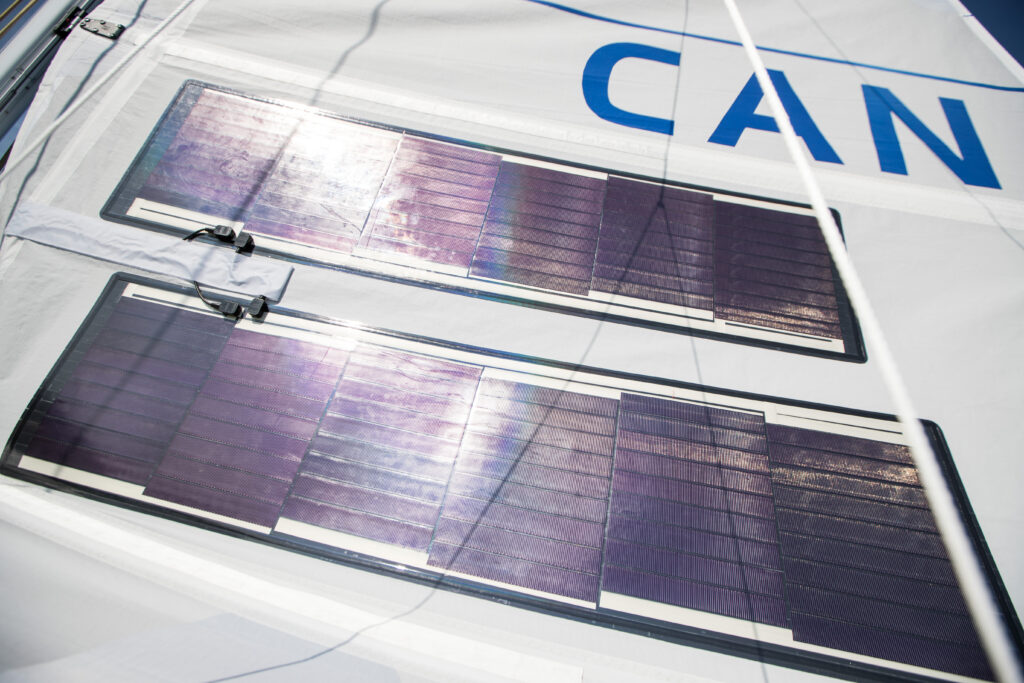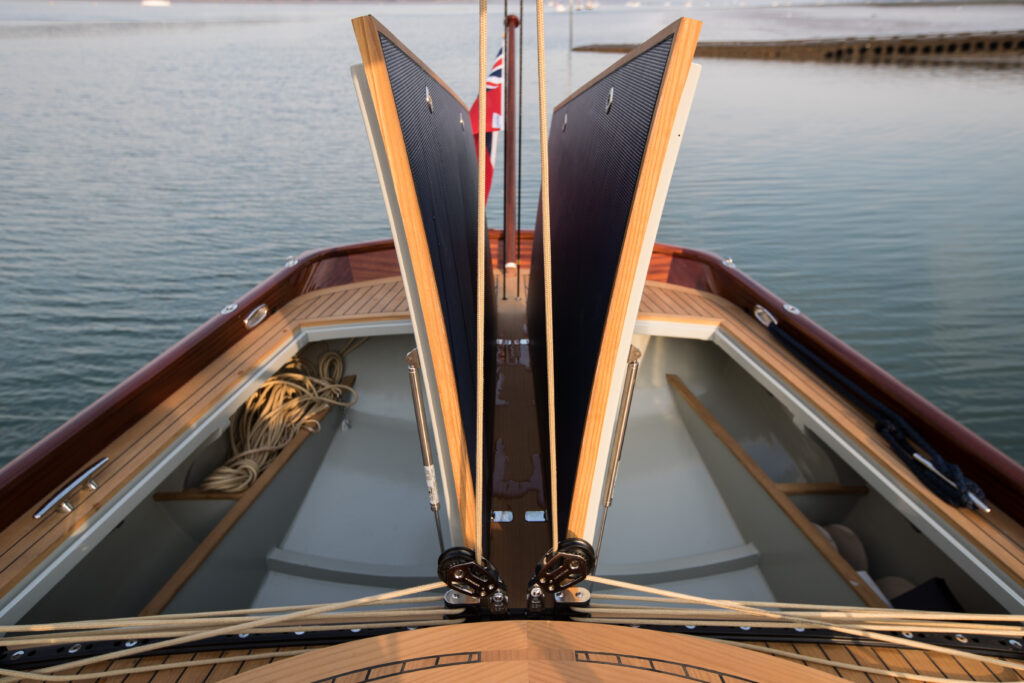
Spirit Yachts lève le voile sur son énergie propre et ses voiles solaires

L'année dernière, Sean McMillan, fondateur de Spirit Yachts, a annoncé que plus de la moitié des bateaux en commande auprès de la société étaient des commandes répétées pour des propriétaires existants, mais chaque propriétaire de commande répétée passait du diesel à l'électrique . Cela le ravit visiblement. Ce n'est un secret pour personne que Spirit a mis l'accent sur le développement durable depuis qu'il a remporté le premier prix environnemental de British Marine au SIBS 2019. Et, dans un récent documentaire de la BBC (Making Waves: Building Boats ), McMillan n'a pas tardé à dénigrer l'état de la production de bateaux au Royaume-Uni.
"Regardez ça", a-t-il dit en regardant une marina, comme on peut en voir partout au Royaume-Uni. « Je trouve cela vraiment déprimant. Des acres et des acres de fibre de verre blanche.
« Le problème avec les marinas comme celle-ci, c'est que 99 % des bateaux qui s'y trouvent sont en fibre de verre. Il laisse derrière lui un héritage vraiment épouvantable. Certains d'entre eux peuvent durer 20/30 ans, mais à ce stade, ils seront très fatigués. C'est indéfendable et ça ne peut pas continuer. »
 Avvento
Avventodispose de panneaux solaires flexibles
Sans avoir à faire face aux problèmes environnementaux du GRP - tous les yachts Spirit sont fabriqués avec du bois d'origine durable (principalement du sapin de Douglas et du sapelli du Canada) - l'entreprise concentre son attention sur la régénération de l'énergie propre utilisée pour la charge de l'hôtel (éclairages intérieurs etc.) et la propulsion électrique.
Voiliers électriques et solaires
En avril 2021, Karen Underwood a été nommée MD de Spirit et a passé le flambeau pour avoir fourni des systèmes de propulsion encore plus efficaces et efficients sur les yachts haut de gamme bien-aimés des réalisateurs de James Bond. Elle a une direction claire pour l'avenir. "Fondamentalement, nous espérons que tout yacht à voile sortant d'ici aura un système d'entraînement électrique à bord ", déclare Underwood.
"En tant qu'industrie, nous devons atteindre des objectifs environnementaux mondiaux et promouvoir et faciliter l'utilisation de yachts à propulsion électrique. Nous devons être efficaces dans la régénération et la gestion de l'énergie, en réduisant l'empreinte carbone et en ayant moins d'impact sur l'environnement. C'est là que nous devons tous être. Et c'est ce qui se reflète dans notre cour. C'est quelque chose que je peux dire, mais c'est aussi quelque chose que nous pouvons sauvegarder.
Cette sauvegarde s'accompagne d'un héritage impressionnant né d'un désir d'innover et de l'intérêt des clients pour les yachts durables. Détails sous- bois Avvento ; le propriétaire vit totalement hors réseau au Canada dans son 44CR électrique (conception de course-croisière), construit dans le chantier d'Ipswich en 2020 . En plus d'un système d'entraînement de voile Oceanvolt pour générer de l'énergie (via l'hélice) pendant la navigation, de panneaux solaires sur le pont et d'une petite éolienne pour rendre le bateau aussi autonome que possible, Avvento comprend des panneaux solaires flexibles fixés à la grand-voile pour maximiser l'énergie solaire. énergie.
"Les panneaux sont tous cousus ou collés sur la voile", explique Underwood. Au moment où Spirit suggérait (et adoptait) cette technologie, les voiles solaires étaient presque inconnues. "La technologie solaire a définitivement progressé et nous pouvons donc façonner les panneaux solaires pour capter la lumière du soleil afin de la convertir en énergie à des moments particuliers de la journée."

Les voiles intègrent des panneaux solaires flexibles
Underwood poursuit : "Le propriétaire d' Avvento travaille maintenant avec John Parker de OneSails et dit" en fait, à cette heure de la journée, j'aurais pu capturer le soleil quand il était plus bas que l'eau - pourrions-nous envisager d'avoir une forme différente, ou size de panneau?' Il travaille directement avec OneSails, et avec nous, pour tirer le meilleur parti des panneaux solaires.
Comme le note James Weller, électricien en chef de Spirit, il y a actuellement un coût important à choisir l'électricité plutôt que le diesel. « Plus on l'adoptera, plus le prix baissera », dit-il pragmatiquement. Il est un ardent défenseur de la technologie de régénération.
"Le solaire est actuellement le meilleur moyen de recharger le système en continu", déclare Weller. « Les panneaux modernes deviennent de plus en plus efficaces, même par temps nuageux. Mais lorsque vous naviguez, si vous obtenez des conditions optimales, vous pouvez vraiment redonner une quantité décente de puissance au yacht en utilisant la régénération via l'hélice.

Panneaux solaires intégrés sur le pont de l'Avvento
Alors que Weller tient à souligner que les données autonomes peuvent être trompeuses car des facteurs tels que les conditions météorologiques et la manipulation affecteront cette capacité de régénération, il dit que, dans de bonnes conditions de navigation pendant une heure, il a été témoin d'une moyenne de 900 watts mis en continu. retour dans le système.
Technologie de régénération
Spirit travaille actuellement avec quelques fournisseurs de technologie de régénération et de propulsion électrique, testant de nouveaux systèmes avant de s'engager pleinement. Actuellement dans le mix se trouvent Torqeedo , Oceanvolt et dernièrement ePropulsion (destiné au second Spirit 30).
"Nous ne pouvons pas nous permettre d'être totalement mariés à un seul fournisseur à cause de ce qui se passe dans le monde en ce moment", déclare Underwood. « Certains propriétaires aiment garder tous les systèmes identiques, d'autres fois ils ne le font pas. Certains de nos propriétaires s'impliquent énormément dans l'élément d'approvisionnement et traitent directement avec les fabricants, ce qui est formidable car nous pouvons tous assurer la liaison et il n'y a pas de mauvaise gestion dans la communication. Cela signifie également que nous poussons le fournisseur. Nous repoussons les limites tout le temps.
Weller est d'accord : « Nous essayons de faire en sorte que leurs produits soient meilleurs, ce qui améliore purement et simplement nos produits. Nous essayons toujours d'amener les fournisseurs à rendre leur produit aussi bon que possible car ils sont attachés à notre produit. Par exemple, nous avons fait des ajustements de conception avec Oceanvolt concernant ses installations et son système de gestion de batterie, jusqu'à l'éclairage de ses manettes et comment cela est programmé. Il y a beaucoup de petites modifications qui s'additionnent.
Bateaux électriques sur mesure
Selon Underwood, Weller fait beaucoup de R&D (résolution de problèmes mathématiques) avec des fournisseurs et des clients et est devenu, au cours des 21 dernières années, le centre de connaissances incontournable sur la côte Est pour obtenir des conseils en matière de technologie de régénération et de conduite.
Désormais, Spirit s'oriente vers l'utilisation des batteries MG. Underwood cite leurs performances sur le bateau à moteur P70 comme étant déterminantes pour prendre la décision, ainsi que le fait qu '«ils fonctionnent très bien avec le reste du système».
Mais alors que Spirit préconise ouvertement la régénération et les entraînements électriques, Underwood et Weller notent que tous les propriétaires ne sont pas si ouverts à s'éloigner des combustibles fossiles. "Je pense qu'il s'agit de changer les perceptions, d'explorer des avenues et de passer du temps avec des gens comme James qui sait de quoi il parle, qui peut diriger et déplacer les gens dans l'espace de dire" en fait, je vais passer à l'éco et ça ne va pas. coûte au monde entier et c'est très facile à gérer », déclare Underwood.
« Nous avons des clients qui viennent nous voir et qui ont peut-être quelque chose en tête. Comme un client qui voulait un voilier de 52 pieds avec un moteur diesel. Il a passé 45 minutes avec James à bord de l'un de nos yachts hybrides et de l'un de nos yachts entièrement électriques, et est reparti en pensant "non, j'aurai un Oceanvolt avec éventuellement un générateur de secours".
Comme tous les constructeurs de bateaux traditionnels, cette flexibilité d'adaptation aux décisions changeantes est la clé des processus de Spirit. En tant que constructeur et concepteur de yachts sur mesure, Spirit peut être très flexible dans sa construction. Sans les restrictions des moules, la société adapte absolument tous les systèmes à bord de l'un de ses yachts.
« Nous pouvons produire ce que les gens veulent car nous n'avons pas les moules. Le problème pour certains des fabricants de GRPest évidemment leur production est limitée avec leurs outils de moulage. Ils essaient de créer un emballage standard à taille unique, comme ils le doivent en fin de compte », déclare Underwood. « Si vous avez affaire à quelque chose qui sort d'un moule, en fin de compte, vous ne pouvez pas y changer grand-chose en termes d'économie d'échelle. Si comme nous vous innovez partout, c'est bien, vous pouvez avoir un 30 électrique ou un 111 électrique. Nous avons la capacité d'ingénierie et les connaissances électriques et le savoir-faire pour manipuler la coque pour faire ce que nous aimerions qu'elle fasse, plutôt que dans l'autre sens.
Weller dit que Spirit n'innove pas seulement à la demande du client ; il cherche toujours des moyens de propulser les yachts à l'avenir . Actuellement, il étudie les piles à hydrogène pour voir s'il est possible d'utiliser des carburants synthétiques. « Nous recherchons constamment des moyens d'améliorer davantage la scène des yachts. Ce n'est pas comme si nous étions passés à un système d'entraînement électrique et que nous étions passés au « c'est tout maintenant ». Nous cherchons toujours à nous améliorer. Les entraînements électriques sont excellents mais présentent toujours des inconvénients en termes d'autonomie et de nécessité d'avoir beaucoup de batteries à bord. Nous cherchons toujours de nouvelles options.
Toutes les images sont une gracieuseté de Spirit Yachts/Richard Langdon.
Le message Spirit Yachts lève le voile sur son énergie propre et les voiles solaires sont apparues en premier sur Marine Industry News .
